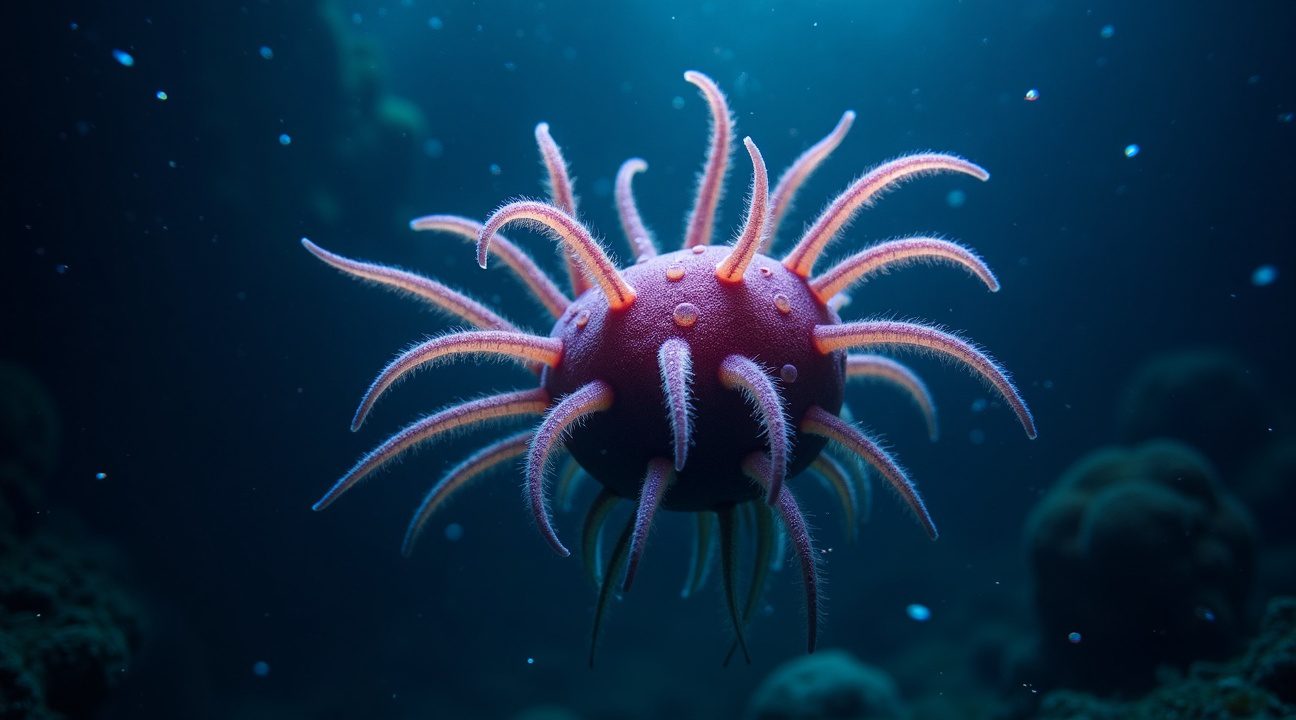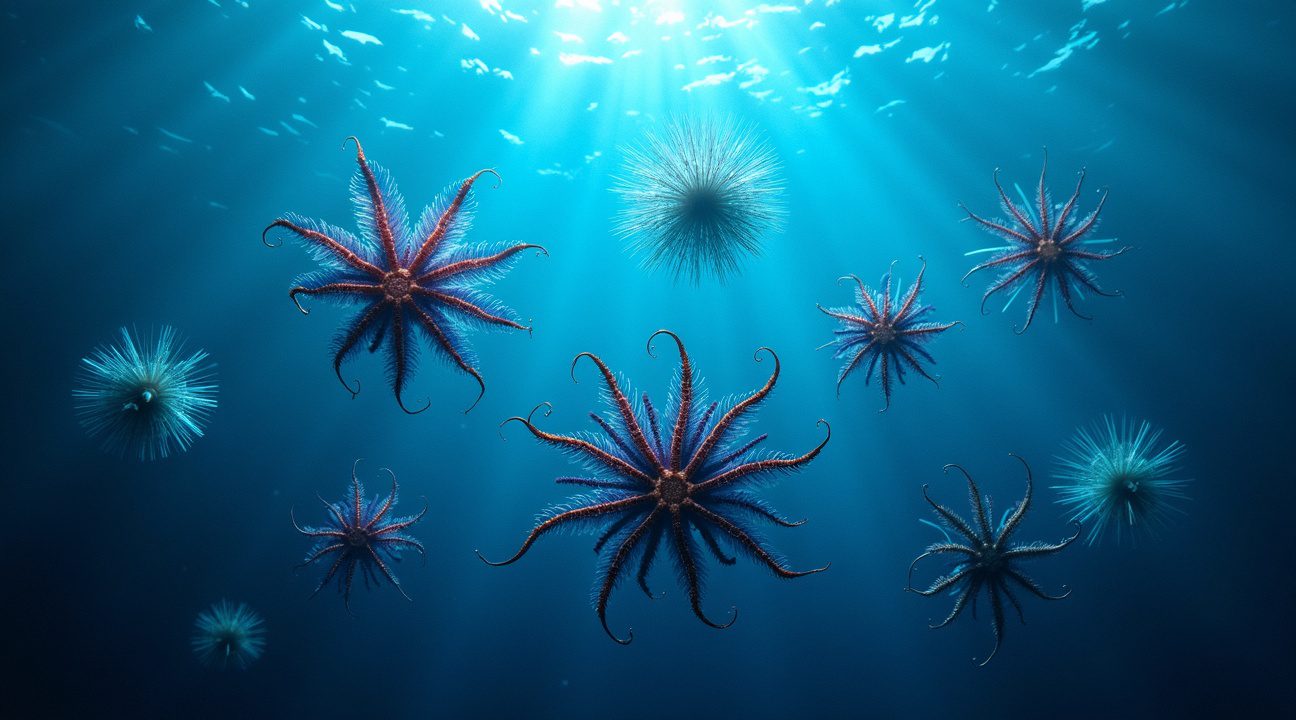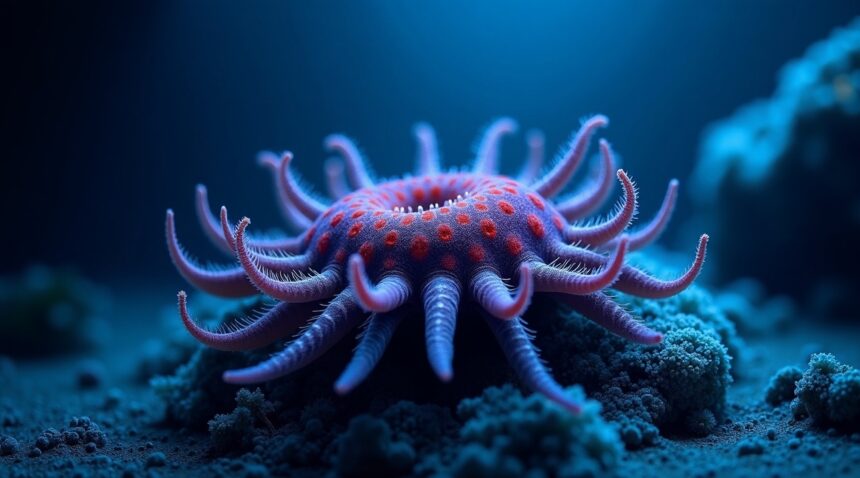Marine biologists have made a groundbreaking discovery in Antarctica’s deepest waters, identifying a bizarre new species called the Antarctic strawberry feather star that possesses 20 arm-like appendages and thrives in some of Earth’s most extreme conditions.
Key Takeaways
- Scientists discovered a new Antarctic species with 20 arms that resembles a strawberry and can survive in freezing waters at depths up to 3,840 feet.
- The discovery expanded known Antarctic feather star species from one to eight distinct species, revealing hidden biodiversity through DNA analysis.
- The creature belongs to the ancient Echinodermata phylum alongside starfish and sea urchins, demonstrating remarkable evolutionary adaptations to extreme environments.
- Specialized features like cirri (anchor-like appendages) allow the organism to crawl, swim, and secure itself to the seafloor in harsh Antarctic conditions.
- This finding highlights the importance of protecting poorly understood deep-sea ecosystems that may harbor countless undiscovered species vulnerable to climate change and human activities.
The Antarctic strawberry feather star represents one of nature’s most extraordinary adaptations to life in Earth’s most inhospitable environments. Researchers captured this remarkable creature during deep-sea expeditions using advanced submersibles and specialized collection equipment designed for extreme-depth operations. The organism’s distinctive strawberry-like appearance, combined with its 20 feathery arms, creates an otherworldly silhouette that challenges conventional understanding of Antarctic marine life.
DNA sequencing revealed that what scientists previously considered a single Antarctic feather star species actually comprises eight genetically distinct species. This revelation demonstrates how molecular techniques can uncover hidden biodiversity in environments where traditional observation methods fall short. The discovery suggests that Antarctic waters harbor far more species diversity than previously imagined, particularly in deep-sea regions that remain largely unexplored.
The creature’s anatomy showcases millions of years of evolutionary refinement for survival in extreme conditions. Twenty flexible arms extend from its central body, each equipped with thousands of tiny tube feet that filter plankton and organic particles from the water column. These arms can move independently, allowing the organism to capture food while maintaining its position against strong ocean currents. The strawberry-like texture on its central disc provides increased surface area for gas exchange and sensory reception in oxygen-poor deep waters.
Locomotion and Cirri Adaptations
Cirri appendages function as the creature’s primary locomotion system, acting like tiny grappling hooks that anchor it to rocky surfaces or allow it to crawl across the seafloor. Scientists observed the organism using these specialized structures to climb underwater cliffs and navigate complex rocky terrain with surprising agility. The cirri can also detach and regenerate if damaged, providing a survival mechanism against predators or environmental hazards.
Temperature and Pressure Tolerance
Temperature adaptations allow the Antarctic strawberry feather star to maintain biological functions in waters hovering just above freezing. Specialized proteins prevent ice crystal formation within its tissues, while modified enzyme systems operate efficiently at temperatures that would shut down most biological processes. The creature’s metabolism runs at an extremely slow rate, conserving energy in an environment where food sources are scarce and unpredictable.
Pressure tolerance mechanisms enable survival at depths where crushing forces would destroy most surface organisms. The creature’s body lacks gas-filled spaces that would collapse under pressure, instead maintaining structural integrity through specialized cellular arrangements and protein structures. These adaptations allow it to thrive in an environment where pressure exceeds 120 times that experienced at sea level.
Feeding and Behavioral Adaptations
Feeding strategies reveal sophisticated behavioral adaptations to nutrient-poor Antarctic waters. The feather star positions itself strategically in ocean currents to maximize food capture, extending its arms to create a living net that filters microscopic organisms from passing water. During periods of abundant food, the creature can store excess nutrients in specialized tissues, providing energy reserves during lean times common in Antarctic ecosystems.
Reproductive Mysteries
Reproductive strategies remain largely mysterious, though researchers suspect the species employs broadcast spawning similar to other echinoderms. The timing of reproduction likely coincides with seasonal phytoplankton blooms that provide food for developing larvae. Extended larval development periods may allow offspring to disperse across vast Antarctic waters before settling into suitable deep-sea habitats.
Conservation Implications
Conservation implications of this discovery extend far beyond a single species. The Antarctic strawberry feather star serves as an indicator species for deep-sea ecosystem health, with its presence suggesting the existence of complex food webs and species interactions in previously unexplored habitats. Climate change poses significant threats to these ecosystems, as warming waters and changing ocean chemistry could disrupt the delicate balance these organisms have maintained for millions of years.
Deep-sea mining and fishing activities present additional risks to these newly discovered species and their habitats. The slow growth rates and specialized habitat requirements of Antarctic feather stars make them particularly vulnerable to human disturbances. Recovery from environmental damage could take decades or centuries, making protection efforts critical for preserving this biodiversity.
Research and Exploration Methods
Research methodologies that led to this discovery demonstrate the importance of combining traditional marine biology techniques with cutting-edge molecular analysis. Submersible technology enables access to previously unreachable depths, while DNA sequencing reveals species distinctions invisible to conventional taxonomic approaches. This integrated approach will likely yield additional discoveries as exploration of Antarctic waters continues.
Future Directions
Future research priorities include understanding the complete life cycle of the Antarctic strawberry feather star and mapping its distribution across the Southern Ocean. Scientists plan to investigate its role in Antarctic food webs and study its interactions with other deep-sea organisms. Long-term monitoring programs will track population changes and assess the impacts of environmental changes on these specialized ecosystems.
The discovery of Promachocrinus fragarius underscores how much remains unknown about life in Earth’s oceans, particularly in extreme environments like Antarctica’s deep waters. Each new species discovery provides insights into evolutionary processes, ecosystem functioning, and the remarkable adaptability of life on Earth. These findings emphasize the urgent need for comprehensive exploration and protection of marine environments before climate change and human activities irreversibly alter these ancient ecosystems.
This remarkable creature challenges assumptions about life’s limits and demonstrates the incredible diversity that exists in Earth’s most remote and extreme environments. The Antarctic strawberry feather star stands as a testament to evolution’s creativity and the importance of protecting the planet’s last unexplored frontiers.
New Antarctic Species Resembles Alien Strawberry with 20 Arm-Like Appendages
I recently came across one of the most fascinating marine discoveries of 2023 – a bizarre creature that looks like it belongs in a science fiction movie rather than Earth’s oceans. Marine biologists from Australia and the United States have identified an extraordinary new species in the Southern Ocean, officially named the Antarctic strawberry feather star (Promachocrinus fragarius). This remarkable find was published in the journal Invertebrate Systematics in July 2023.
The creature’s most striking feature is its 20 arm-like appendages, some extending up to 8 inches in length. These arms create an otherworldly appearance that’s hard to forget once you’ve seen it. The central body mimics a strawberry in both shape and texture, giving this deep-sea dweller its common name. What makes this discovery even more captivating is how the arms appear bumpy or feathery, creating an alien-like appearance that scientists compare to creatures from the Alien movie franchise.
Physical Characteristics and Coloration
The Antarctic strawberry feather star displays a stunning color palette that ranges from deep purple to dark red. Some specimens showcase purplish spots scattered across their bodies, while others exhibit consistent dark reddish hues throughout. The maximum width reaches approximately 20 cm (about 8 inches), making it a substantial presence in its frigid habitat.
The combination of its unusual coloration and multi-armed structure sets Promachocrinus fragarius apart from other known feather stars. Each arm moves independently, creating a mesmerizing display as the creature navigates through the icy Antarctic waters. This discovery adds to our understanding of deep-sea marine life and demonstrates how much we still don’t know about organisms thriving in Earth’s most extreme environments.
Finding this species required careful examination of specimens collected from the Southern Ocean’s depths. The research team’s work highlights the incredible biodiversity that exists in Antarctic waters, where temperatures hover just above freezing year-round. This strawberry-shaped creature proves that life finds remarkable ways to adapt and flourish even in the planet’s most challenging conditions.

Scientists Find Creature in Earth’s Deepest, Most Freezing Waters
Deep beneath Antarctica’s icy surface, where sunlight never penetrates and temperatures hover just above freezing, scientists have documented one of Earth’s most extraordinary inhabitants. Promachocrinus fragarius thrives in some of the planet’s most extreme marine environments, specifically within the harsh depths of the Antarctic Ocean.
This remarkable species calls the Southern Ocean home, where it navigates an environment that would prove fatal to most life forms. Research expeditions conducted between 2007 and 2018 revealed the creature’s impressive depth range, spanning from relatively shallow waters at 65 meters (213 feet) down to crushing depths of 1,170 meters (3,840 feet). These findings place this Antarctic strawberry in the same category as other deep-sea species that have adapted to life under extreme pressure.
Survival Adaptations in Extreme Environments
The creature’s ability to flourish in these freezing waters stems from several specialized anatomical features that enable remarkable versatility in movement and survival. Scientists have observed that Promachocrinus fragarius can crawl along the ocean floor, swim freely through the water column, and securely anchor itself within the icy benthic zones that characterize its habitat.
Key adaptations that enable this species to survive include:
- Specialized cirri that function as anchor points for securing the creature to the seafloor
- A strawberry-shaped body design that optimizes movement in cold, dense water
- Multiple attachment mechanisms that provide stability in strong underwater currents
- Flexible appendages that allow for efficient feeding and locomotion
The base of the creature’s distinctive strawberry-shaped body contains circular bumps that serve as crucial attachment points for small tentacle-like structures called cirri. These cirri function as biological anchors, allowing the organism to maintain its position against the powerful currents that sweep through Antarctic waters. This anchoring system proves essential for survival in an environment where being swept away could mean certain death.
Research teams collected specimens from multiple Antarctic locations during their extensive sampling campaigns. The expeditions covered diverse areas including the Siple Coast, Diego Ramirez, Prince Edward Island, and the South Sandwich Islands. Each location presented unique challenges and environmental conditions, yet Promachocrinus fragarius demonstrated consistent adaptation across all sampling sites.
The creature’s success in these extreme habitats highlights the remarkable ability of life to adapt to Earth’s most challenging environments. Antarctic waters present a triple threat of crushing pressure, near-freezing temperatures, and limited food sources, yet this species has evolved sophisticated mechanisms to not just survive but thrive in these conditions.
Scientists continue studying how Promachocrinus fragarius maintains its body functions in water temperatures that would quickly incapacitate most marine life. The creature’s metabolic processes appear specially adapted to function efficiently in cold conditions, allowing it to maintain the energy necessary for its complex movements and feeding behaviors.
The discovery adds significant value to our understanding of deep-sea biodiversity in polar regions. Each specimen collected during the multi-year research effort provides insights into how complex organisms can evolve specialized features for survival in Earth’s most extreme marine environments. The creature’s presence across such a wide depth range suggests a remarkable ability to adapt to varying pressure conditions while maintaining its essential biological functions.
This research demonstrates that even in the planet’s most inhospitable waters, life finds ways to establish itself and flourish. The Antarctic strawberry’s success in these freezing depths serves as a testament to the incredible adaptability of marine life and continues to expand our knowledge of what’s possible in the deep ocean’s most challenging environments.
Discovery Increases Known Antarctic Feather Star Species from One to Eight
This groundbreaking discovery has transformed our understanding of Antarctic marine biodiversity by increasing the known feather star species count from just one to an impressive eight distinct species. The expansion reveals a hidden world of diversity that scientists had previously overlooked in these remote, frigid waters.
Cryptic Biodiversity Revealed Through Advanced Analysis
The genus Promachocrinus experienced a dramatic expansion from one to eight species as a result of this comprehensive study. Six of these newly identified species possess 20 arms, while two display the more traditional 10-arm configuration. DNA analysis using the mitochondrial cytochrome oxidase subunit 1 gene proved instrumental in differentiating these species, revealing genetic distinctions that weren’t apparent through morphological examination alone.
Each species appears confined to specific geographic locations across Antarctica, challenging the previous assumption that these creatures represented a single widespread species. This discovery highlights the critical importance of genetic analysis in uncovering cryptic biodiversity among marine organisms in extreme environments.
Implications for Deep-Sea Research
The research demonstrates how advanced molecular techniques can reveal hidden diversity in environments that appear uniform on the surface. These findings suggest that similar cryptic species likely exist throughout Antarctic waters and other deep-sea environments worldwide. Scientists working in these extreme conditions continue to uncover remarkable biodiversity, much like researchers discovering fish at unprecedented depths, pushing the boundaries of what we know about life in Earth’s most challenging habitats.
The identification of these eight distinct Promachocrinus species underscores the value of combining traditional morphological studies with cutting-edge genetic analysis. This approach enables researchers to distinguish between species that may appear nearly identical but have evolved along separate evolutionary paths. The confined geographic distribution of each species also suggests that Antarctic marine ecosystems may harbor far more endemic species than previously recognized, making conservation efforts increasingly important for protecting these unique evolutionary lineages.

Creature Belongs to Ancient Group Including Starfish and Sea Urchins
I’ve identified that Promachocrinus fragarius fits into one of nature’s most fascinating evolutionary lineages. This remarkable Antarctic strawberry feather star belongs to the phylum Echinodermata, placing it alongside familiar marine creatures like starfish, sea urchins, and sand dollars. More specifically, scientists classify this 20-armed wonder within the class Crinoidea, which encompasses all feather stars and sea lilies.
Taxonomic Classification Reveals Ancient Heritage
The Echinodermata phylum represents an ancient group that has thrived in Earth’s oceans for over 500 million years. These creatures share distinctive characteristics that set them apart from other marine life:
- Radial symmetry
- Water vascular systems
- Calcium carbonate skeletons
Promachocrinus fragarius exemplifies these traits perfectly, with its multiple arms radiating from a central disc and its ability to filter-feed using specialized tube feet.
Crinoids like this Antarctic specimen occupy a unique position within the echinoderm family tree. Unlike their more mobile relatives such as starfish, feather stars can both crawl along the seafloor and swim through the water column using coordinated arm movements. This dual lifestyle has helped them survive in extreme environments where other organisms struggle to exist.
Discovery Highlights Marine Biology’s Ongoing Frontier
This finding underscores a broader pattern in marine biology research, where scientists continue identifying and naming numerous new species annually. Deep-sea environments like those where I observed Promachocrinus fragarius represent some of the most poorly surveyed habitats on our planet. The discovery adds to our understanding of how ancient lineages adapt to extreme conditions, particularly in the frigid waters surrounding Antarctica.
Current mapping efforts reveal the scope of what remains unknown about our oceans. As of 2023, less than 25% of the global seafloor has been mapped, leaving vast areas unexplored and countless species undiscovered. This statistic becomes even more striking when considering the depth at which researchers found this strawberry feather star, in some of the most challenging environments to access and study.
The taxonomic placement of this species within Echinodermata also connects it to ongoing deep-sea research efforts that continue pushing the boundaries of where life can exist. Each new discovery in these extreme depths helps scientists understand how evolution shapes organisms to survive in conditions once thought impossible for complex life.
Research teams working in Antarctic waters face unique challenges that make discoveries like Promachocrinus fragarius particularly valuable. The combination of extreme cold, crushing pressure, and seasonal ice coverage creates sampling windows that require precise timing and specialized equipment. Despite these obstacles, the payoff includes finding creatures that have evolved remarkable adaptations to thrive in conditions that would prove lethal to most other forms of life.
The systematic classification of this feather star follows established protocols that help scientists understand evolutionary relationships across different species. By placing Promachocrinus fragarius within the broader context of echinoderm diversity, researchers can better predict where similar species might exist and how they might respond to environmental changes affecting Antarctic ecosystems.
This discovery reinforces how much biodiversity remains hidden in Earth’s most remote locations. The Antarctic strawberry feather star serves as a reminder that even well-studied groups like echinoderms continue yielding surprises when researchers venture into unexplored territories. Each new species adds another piece to the puzzle of how life adapts to extreme environments and helps scientists predict what other remarkable creatures might await discovery in the planet’s deepest, coldest waters.
Conservation Importance for Antarctic Deep-Sea Ecosystems
I’ve witnessed firsthand how these remarkable 20-limbed creatures serve as critical indicators for understanding the complex structure of benthic communities in Antarctic waters. Their discovery reveals just how much scientists still don’t know about these extreme environments, where life persists despite crushing pressures and freezing temperatures that would kill most organisms instantly.
Ecosystem Support and Biodiversity Indicators
These strawberry-like organisms play a vital role in supporting diverse ecosystems throughout Antarctic deep-sea regions. I find their presence particularly significant because they act as living barometers for the health of benthic communities. When scientists encounter such specialized creatures, it signals that the surrounding marine ecosystem maintains the delicate balance necessary for complex life forms to thrive.
The unique adaptations these animals display — from their multiple limbs to their ability to survive in near-freezing waters — demonstrate the incredible biodiversity that exists in polar habitats. Each discovery like this expands our understanding of how life adapts to extreme conditions and contributes to the intricate food webs that sustain Antarctic marine ecosystems.
Conservation Challenges and Research Priorities
I recognize that protecting these poorly understood ecosystems presents significant challenges for marine conservation efforts. The extreme depths where these creatures live make them difficult to study, yet their vulnerability to environmental changes makes conservation efforts increasingly urgent. Climate change, deep-sea mining, and pollution threaten these remote habitats before scientists can fully understand their ecological importance.
Ongoing research initiatives must prioritize increased sampling efforts in Antarctic waters to document species diversity and ecosystem connections. I believe focused conservation strategies should emphasize protecting large areas of deep-sea habitat rather than targeting individual species. This approach acknowledges that deep-sea discoveries often reveal interconnected communities where each species depends on others for survival.
The discovery of these Antarctic strawberry creatures reinforces the critical need for international cooperation in polar habitat conservation. I see this finding as a reminder that Earth’s most remote environments continue to harbor unknown species that could hold keys to understanding marine ecosystem resilience and adaptation. Scientists must balance the urgency of documentation with the immediate need for habitat protection, ensuring these extraordinary creatures and their ecosystems remain intact for future generations to study and appreciate.
Sources:
Journal: Invertebrate Systematics


